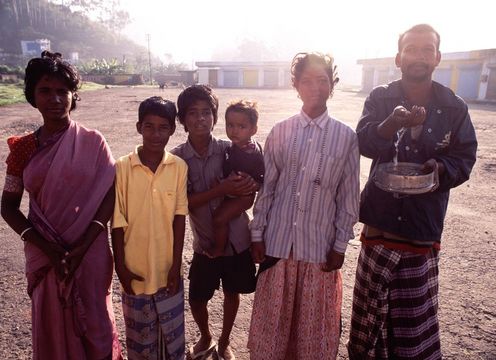 This family was in the bus station in Munnar and insisted that I take their picture. The funniest part about it was that the guy on the right -- apparently the father -- kept pouring the water in his hands. I think it was so that it would look like it was frozen in the picture, but he didn't speak enough English to make it clear.
This family was in the bus station in Munnar and insisted that I take their picture. The funniest part about it was that the guy on the right -- apparently the father -- kept pouring the water in his hands. I think it was so that it would look like it was frozen in the picture, but he didn't speak enough English to make it clear. |
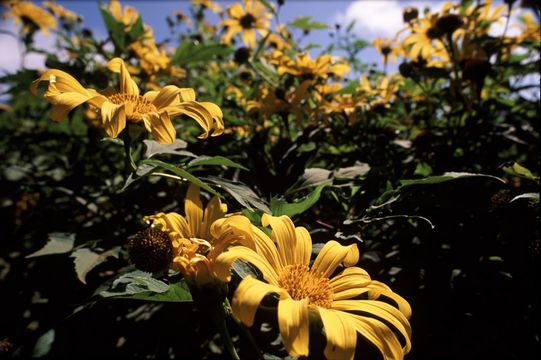 Pretty flowers on a hillside in Munnar.
Pretty flowers on a hillside in Munnar. |
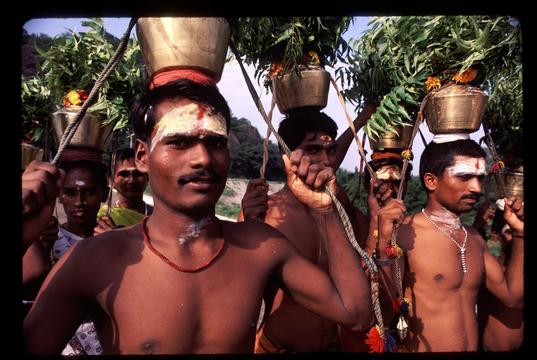 Hindu worshippers on top of a dam near Munnar, Kerala.
Hindu worshippers on top of a dam near Munnar, Kerala. |
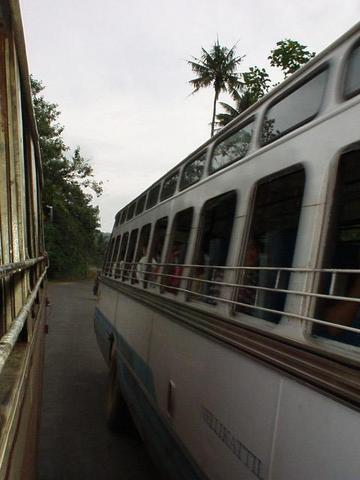 This is just to give you an idea about what it's like driving on the roads of the Nilgiri hills; busses nuzzle past each other at two miles per hour, sometimes with less than a foot between them.
This is just to give you an idea about what it's like driving on the roads of the Nilgiri hills; busses nuzzle past each other at two miles per hour, sometimes with less than a foot between them. |
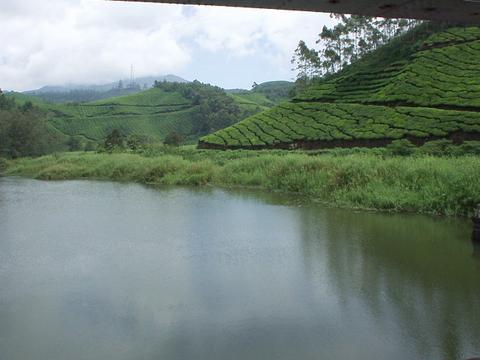 More tea.
More tea. |
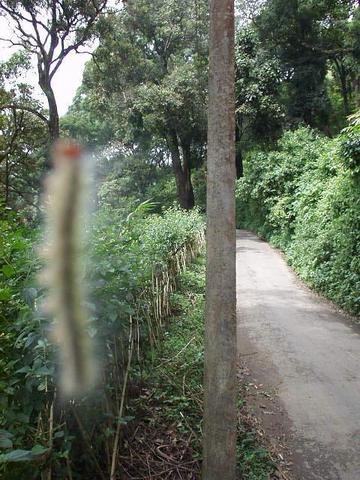 I saw several of these caterpillars descending from the trees on silken threads. Two men walking down the same lane as I was trying (with limited success) to take a picture of this one indicated by gestures that they have a poisonous sting.
I saw several of these caterpillars descending from the trees on silken threads. Two men walking down the same lane as I was trying (with limited success) to take a picture of this one indicated by gestures that they have a poisonous sting. |
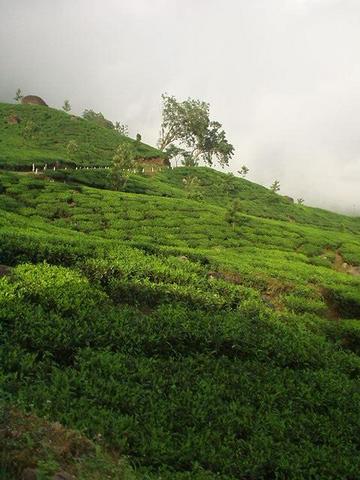 It's like this for miles around Munnar: rolling hills with low, well trimmed tea shrubs.
It's like this for miles around Munnar: rolling hills with low, well trimmed tea shrubs. |
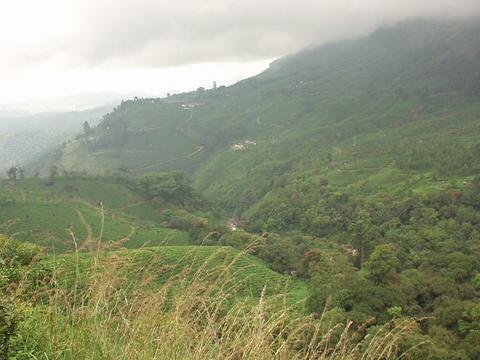 Munnar is at an altitude of 5000 feet, and some of the surrounding hills are higher; it's almost, but not quite, high enough to be rid of the mosquitoes.
Munnar is at an altitude of 5000 feet, and some of the surrounding hills are higher; it's almost, but not quite, high enough to be rid of the mosquitoes. |
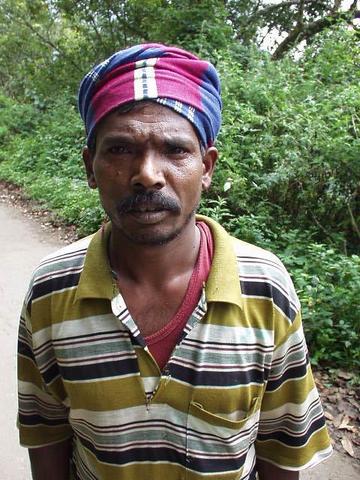 This is one of the two fellows who told me that it was imprudent to touch the caterpillars.
This is one of the two fellows who told me that it was imprudent to touch the caterpillars. |
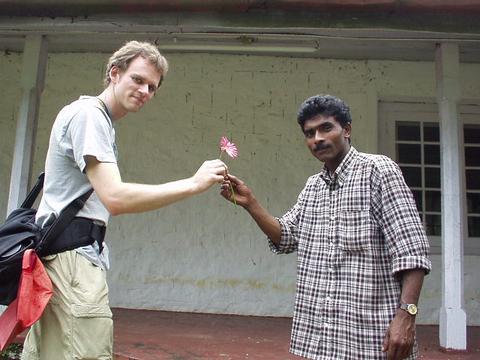 Rajan, like many average Indians, haven't seen a digital camera before, and he was gobsmacked to see pictures on the back of my camera right after I took them. We were about to say goodbye when I showed it to him, and he bolted to find his wife; when he couldn't find her, he contented himself with composing this picture using my tripod.
Rajan, like many average Indians, haven't seen a digital camera before, and he was gobsmacked to see pictures on the back of my camera right after I took them. We were about to say goodbye when I showed it to him, and he bolted to find his wife; when he couldn't find her, he contented himself with composing this picture using my tripod. |
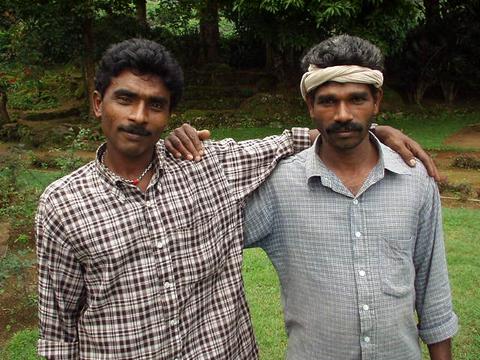 Rajan called over The Assistant Manager's gardner (Rajan is the cook; the actual Assistant Manager was nowhere to be found) to also get his picture taken.
Rajan called over The Assistant Manager's gardner (Rajan is the cook; the actual Assistant Manager was nowhere to be found) to also get his picture taken. |
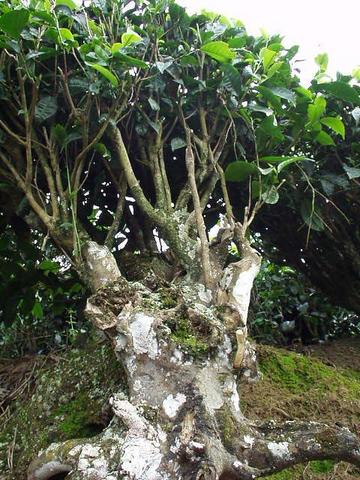 Here you can see an indvidual tea plant, hanging on to a steep ledge. Top quality tea plants, like this one, don't produce any good leaves for at least five years, but they can live for up to one hundred and fifty years. Later, near Ooty, a guide pointed out faster growing varieties that can produce in two but die after sixty and produce lower-grade tea; they look more spindly and do not have lichens growing on them, like this one does.
Here you can see an indvidual tea plant, hanging on to a steep ledge. Top quality tea plants, like this one, don't produce any good leaves for at least five years, but they can live for up to one hundred and fifty years. Later, near Ooty, a guide pointed out faster growing varieties that can produce in two but die after sixty and produce lower-grade tea; they look more spindly and do not have lichens growing on them, like this one does. |
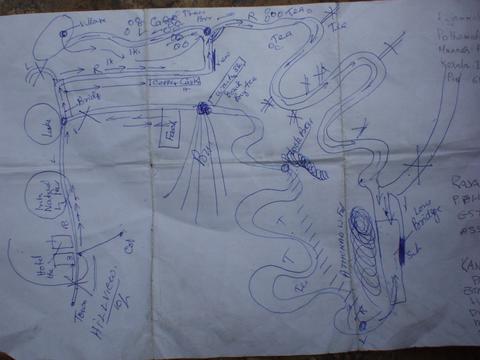 This is the map that Joseph Iype -- who receives rare praise from Lonely Planet, and justifiably so -- drew for me to take a walk through a nearby village, through the plantations, and then by Athukad waterfall. I went on a car tour with three Germans that were also staying in Joseph's cottage, and they had the exact same map: but Joseph draws it each time, and the four of us were joking about how he would go over each section at least three times.
This is the map that Joseph Iype -- who receives rare praise from Lonely Planet, and justifiably so -- drew for me to take a walk through a nearby village, through the plantations, and then by Athukad waterfall. I went on a car tour with three Germans that were also staying in Joseph's cottage, and they had the exact same map: but Joseph draws it each time, and the four of us were joking about how he would go over each section at least three times. |
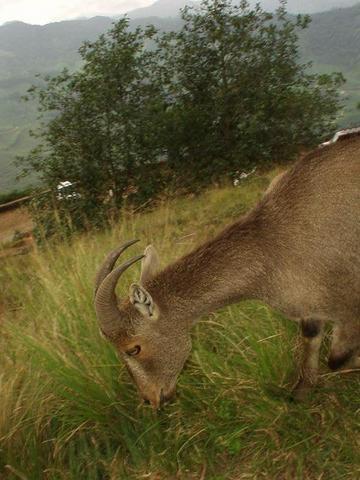 The Nilgiri Tahr is a mountain goat that now survives primarily in protected areas; they have a startlingly small "threat zone"; it's possible to walk up to ten or even five feet of one before they start to move away.
The Nilgiri Tahr is a mountain goat that now survives primarily in protected areas; they have a startlingly small "threat zone"; it's possible to walk up to ten or even five feet of one before they start to move away. |
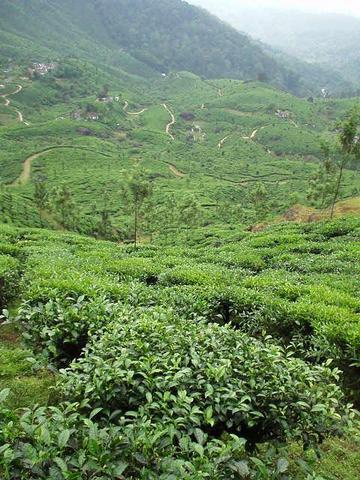 It's a similar feeling of immense agriculture that you get in Iowa with corn, except it's hilly so you can see further, there are dramatic cliffs and mountains in the distance, and the people are all Indians. Okay, so maybe it's not much like Iowa at all.
It's a similar feeling of immense agriculture that you get in Iowa with corn, except it's hilly so you can see further, there are dramatic cliffs and mountains in the distance, and the people are all Indians. Okay, so maybe it's not much like Iowa at all. |
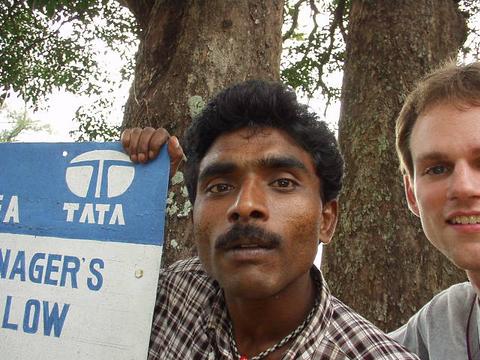 Somewhat lacking in compositional style, but here's Rajan and me in front of the Asst. Manager's bungalow sign.
Somewhat lacking in compositional style, but here's Rajan and me in front of the Asst. Manager's bungalow sign. |
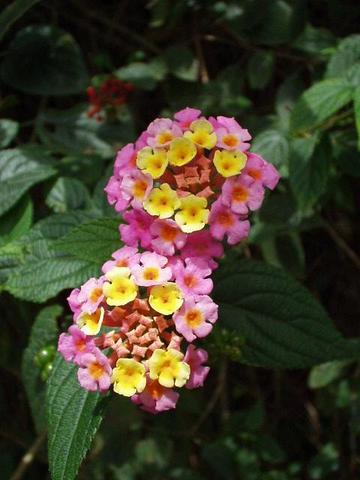 I asked several Indians if they knew the name of this flower, to no avail. Herve, a French doctor I met on the train to Ooty a week later, told me that these are called "vellipeuse" in French
I asked several Indians if they knew the name of this flower, to no avail. Herve, a French doctor I met on the train to Ooty a week later, told me that these are called "vellipeuse" in French |
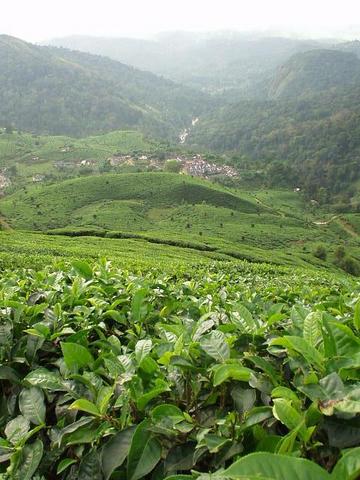 The tea ladies each pick the bud and two mature leaves, although for some lower quality teas they may pick three or even four leaves and the bud.
The tea ladies each pick the bud and two mature leaves, although for some lower quality teas they may pick three or even four leaves and the bud. |
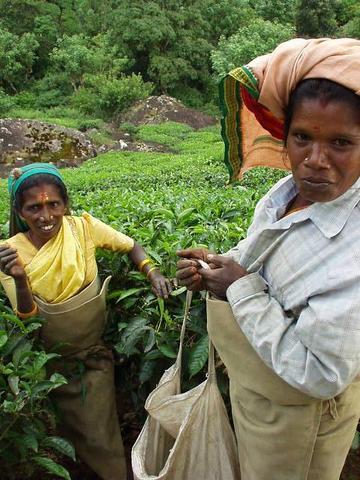 Like Rajan, these women were all but overwhelmed at the opportunity to take a look at my camera. Kannaya, the one on the right, was just excited that it was a camera at all, and first looked through the lens. Then I showed her first how to look through the viewfinder, then how she could see her picture on the back. She spoke decent English, and gave me one of four addresses that I got in as many hours while walking around the Tata plantation, all of people who wanted me to send them their picture. Kannaya makes $1.50 a day -- although if I understood another man I asked the next day, that's base pay, and if you pick more than the 18 kg quota (some people can do up to 80 kg in a day), you get a bonus, plus free education for your children and an average 20% year-end bonus.
Like Rajan, these women were all but overwhelmed at the opportunity to take a look at my camera. Kannaya, the one on the right, was just excited that it was a camera at all, and first looked through the lens. Then I showed her first how to look through the viewfinder, then how she could see her picture on the back. She spoke decent English, and gave me one of four addresses that I got in as many hours while walking around the Tata plantation, all of people who wanted me to send them their picture. Kannaya makes $1.50 a day -- although if I understood another man I asked the next day, that's base pay, and if you pick more than the 18 kg quota (some people can do up to 80 kg in a day), you get a bonus, plus free education for your children and an average 20% year-end bonus. |
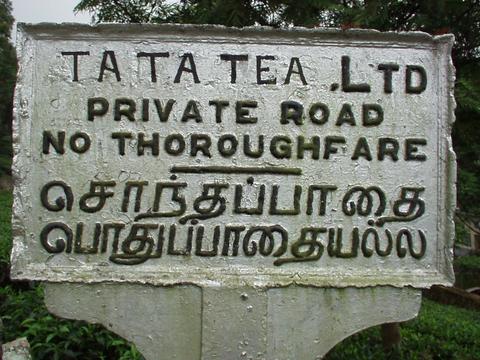 This was the sign at the end of the road that I had been walking on throughout the Tata Tea plantation: "No Thoroughfare" evidently means "No Vehicular Thoroughfare."
This was the sign at the end of the road that I had been walking on throughout the Tata Tea plantation: "No Thoroughfare" evidently means "No Vehicular Thoroughfare." |
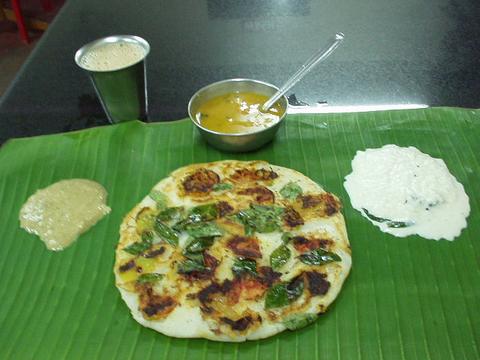 Restaurants (or, as they are frequently called, "hotels") usually advertise as being "veg/non-veg" or "pure veg". The "pure veg" restaurants usually serve the food on a banana leaf, like this tomato oothappam at the Saravana Bhavan in Munnar.
Restaurants (or, as they are frequently called, "hotels") usually advertise as being "veg/non-veg" or "pure veg". The "pure veg" restaurants usually serve the food on a banana leaf, like this tomato oothappam at the Saravana Bhavan in Munnar. |
 This family was in the bus station in Munnar and insisted that I take their picture. The funniest part about it was that the guy on the right -- apparently the father -- kept pouring the water in his hands. I think it was so that it would look like it was frozen in the picture, but he didn't speak enough English to make it clear.
This family was in the bus station in Munnar and insisted that I take their picture. The funniest part about it was that the guy on the right -- apparently the father -- kept pouring the water in his hands. I think it was so that it would look like it was frozen in the picture, but he didn't speak enough English to make it clear. Pretty flowers on a hillside in Munnar.
Pretty flowers on a hillside in Munnar. Hindu worshippers on top of a dam near Munnar, Kerala.
Hindu worshippers on top of a dam near Munnar, Kerala. This is just to give you an idea about what it's like driving on the roads of the Nilgiri hills; busses nuzzle past each other at two miles per hour, sometimes with less than a foot between them.
This is just to give you an idea about what it's like driving on the roads of the Nilgiri hills; busses nuzzle past each other at two miles per hour, sometimes with less than a foot between them. More tea.
More tea. I saw several of these caterpillars descending from the trees on silken threads. Two men walking down the same lane as I was trying (with limited success) to take a picture of this one indicated by gestures that they have a poisonous sting.
I saw several of these caterpillars descending from the trees on silken threads. Two men walking down the same lane as I was trying (with limited success) to take a picture of this one indicated by gestures that they have a poisonous sting. It's like this for miles around Munnar: rolling hills with low, well trimmed tea shrubs.
It's like this for miles around Munnar: rolling hills with low, well trimmed tea shrubs. Munnar is at an altitude of 5000 feet, and some of the surrounding hills are higher; it's almost, but not quite, high enough to be rid of the mosquitoes.
Munnar is at an altitude of 5000 feet, and some of the surrounding hills are higher; it's almost, but not quite, high enough to be rid of the mosquitoes. This is one of the two fellows who told me that it was imprudent to touch the caterpillars.
This is one of the two fellows who told me that it was imprudent to touch the caterpillars. Rajan, like many average Indians, haven't seen a digital camera before, and he was gobsmacked to see pictures on the back of my camera right after I took them. We were about to say goodbye when I showed it to him, and he bolted to find his wife; when he couldn't find her, he contented himself with composing this picture using my tripod.
Rajan, like many average Indians, haven't seen a digital camera before, and he was gobsmacked to see pictures on the back of my camera right after I took them. We were about to say goodbye when I showed it to him, and he bolted to find his wife; when he couldn't find her, he contented himself with composing this picture using my tripod. Rajan called over The Assistant Manager's gardner (Rajan is the cook; the actual Assistant Manager was nowhere to be found) to also get his picture taken.
Rajan called over The Assistant Manager's gardner (Rajan is the cook; the actual Assistant Manager was nowhere to be found) to also get his picture taken.  Here you can see an indvidual tea plant, hanging on to a steep ledge. Top quality tea plants, like this one, don't produce any good leaves for at least five years, but they can live for up to one hundred and fifty years. Later, near Ooty, a guide pointed out faster growing varieties that can produce in two but die after sixty and produce lower-grade tea; they look more spindly and do not have lichens growing on them, like this one does.
Here you can see an indvidual tea plant, hanging on to a steep ledge. Top quality tea plants, like this one, don't produce any good leaves for at least five years, but they can live for up to one hundred and fifty years. Later, near Ooty, a guide pointed out faster growing varieties that can produce in two but die after sixty and produce lower-grade tea; they look more spindly and do not have lichens growing on them, like this one does. This is the map that Joseph Iype -- who receives rare praise from Lonely Planet, and justifiably so -- drew for me to take a walk through a nearby village, through the plantations, and then by Athukad waterfall. I went on a car tour with three Germans that were also staying in Joseph's cottage, and they had the exact same map: but Joseph draws it each time, and the four of us were joking about how he would go over each section at least three times.
This is the map that Joseph Iype -- who receives rare praise from Lonely Planet, and justifiably so -- drew for me to take a walk through a nearby village, through the plantations, and then by Athukad waterfall. I went on a car tour with three Germans that were also staying in Joseph's cottage, and they had the exact same map: but Joseph draws it each time, and the four of us were joking about how he would go over each section at least three times. The Nilgiri Tahr is a mountain goat that now survives primarily in protected areas; they have a startlingly small "threat zone"; it's possible to walk up to ten or even five feet of one before they start to move away.
The Nilgiri Tahr is a mountain goat that now survives primarily in protected areas; they have a startlingly small "threat zone"; it's possible to walk up to ten or even five feet of one before they start to move away. It's a similar feeling of immense agriculture that you get in Iowa with corn, except it's hilly so you can see further, there are dramatic cliffs and mountains in the distance, and the people are all Indians. Okay, so maybe it's not much like Iowa at all.
It's a similar feeling of immense agriculture that you get in Iowa with corn, except it's hilly so you can see further, there are dramatic cliffs and mountains in the distance, and the people are all Indians. Okay, so maybe it's not much like Iowa at all. Somewhat lacking in compositional style, but here's Rajan and me in front of the Asst. Manager's bungalow sign.
Somewhat lacking in compositional style, but here's Rajan and me in front of the Asst. Manager's bungalow sign. I asked several Indians if they knew the name of this flower, to no avail. Herve, a French doctor I met on the train to Ooty a week later, told me that these are called "vellipeuse" in French
I asked several Indians if they knew the name of this flower, to no avail. Herve, a French doctor I met on the train to Ooty a week later, told me that these are called "vellipeuse" in French The tea ladies each pick the bud and two mature leaves, although for some lower quality teas they may pick three or even four leaves and the bud.
The tea ladies each pick the bud and two mature leaves, although for some lower quality teas they may pick three or even four leaves and the bud. Like Rajan, these women were all but overwhelmed at the opportunity to take a look at my camera. Kannaya, the one on the right, was just excited that it was a camera at all, and first looked through the lens. Then I showed her first how to look through the viewfinder, then how she could see her picture on the back. She spoke decent English, and gave me one of four addresses that I got in as many hours while walking around the Tata plantation, all of people who wanted me to send them their picture. Kannaya makes $1.50 a day -- although if I understood another man I asked the next day, that's base pay, and if you pick more than the 18 kg quota (some people can do up to 80 kg in a day), you get a bonus, plus free education for your children and an average 20% year-end bonus.
Like Rajan, these women were all but overwhelmed at the opportunity to take a look at my camera. Kannaya, the one on the right, was just excited that it was a camera at all, and first looked through the lens. Then I showed her first how to look through the viewfinder, then how she could see her picture on the back. She spoke decent English, and gave me one of four addresses that I got in as many hours while walking around the Tata plantation, all of people who wanted me to send them their picture. Kannaya makes $1.50 a day -- although if I understood another man I asked the next day, that's base pay, and if you pick more than the 18 kg quota (some people can do up to 80 kg in a day), you get a bonus, plus free education for your children and an average 20% year-end bonus. This was the sign at the end of the road that I had been walking on throughout the Tata Tea plantation: "No Thoroughfare" evidently means "No Vehicular Thoroughfare."
This was the sign at the end of the road that I had been walking on throughout the Tata Tea plantation: "No Thoroughfare" evidently means "No Vehicular Thoroughfare." Restaurants (or, as they are frequently called, "hotels") usually advertise as being "veg/non-veg" or "pure veg". The "pure veg" restaurants usually serve the food on a banana leaf, like this tomato oothappam at the Saravana Bhavan in Munnar.
Restaurants (or, as they are frequently called, "hotels") usually advertise as being "veg/non-veg" or "pure veg". The "pure veg" restaurants usually serve the food on a banana leaf, like this tomato oothappam at the Saravana Bhavan in Munnar.